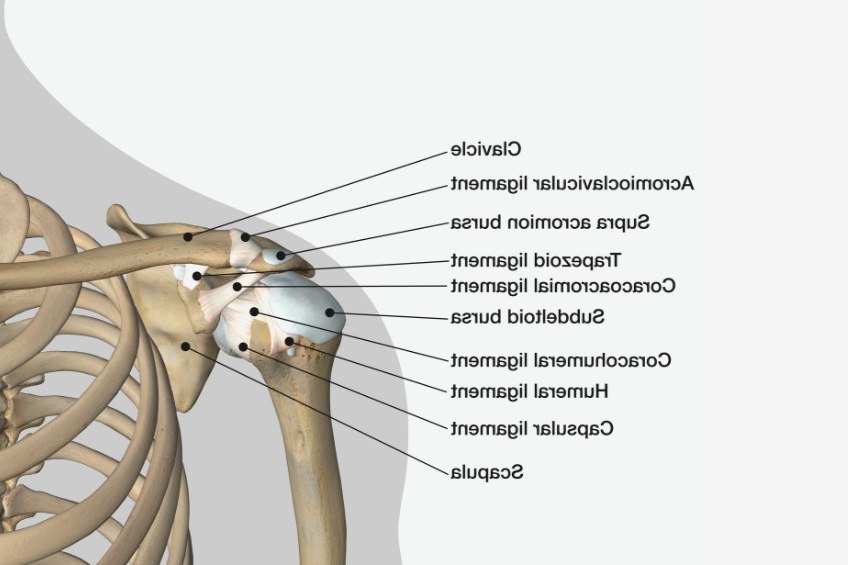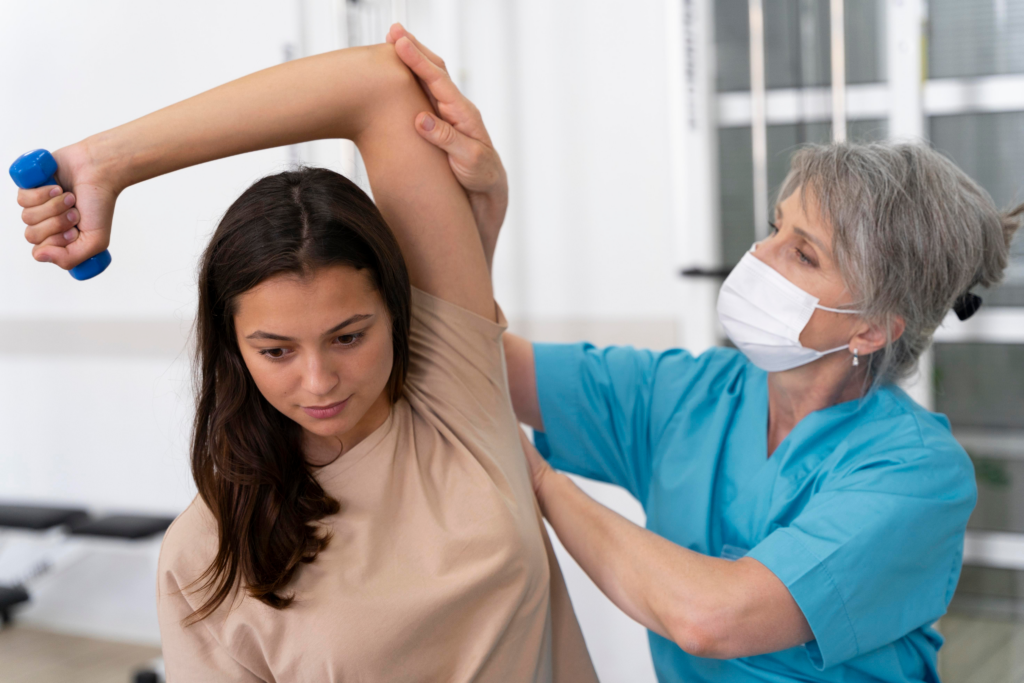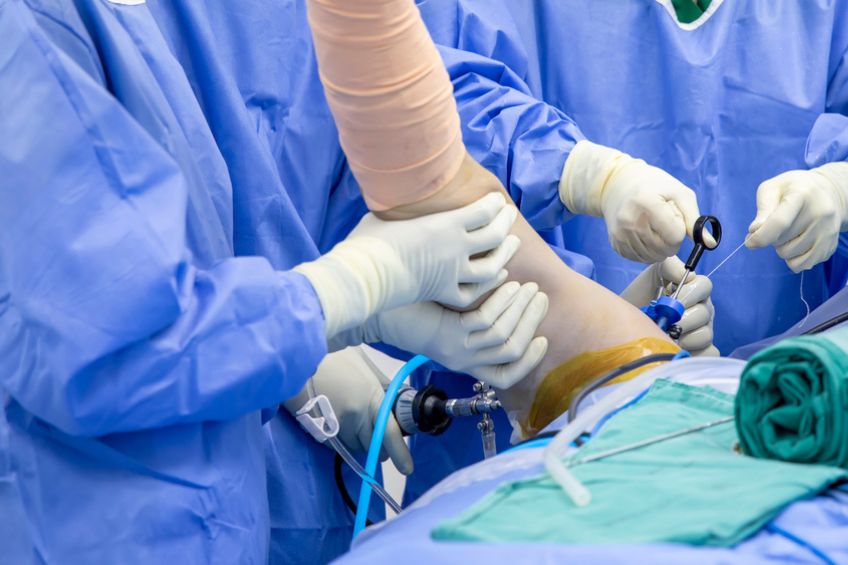Shoulder Arthroscopy

Shoulder Anatomy
The shoulder joint comprises a ball-and-socket structure, where the upper arm bone’s head (humerus) connects with the shoulder blade’s socket, known as the glenoid. Cartilage covers the surfaces of these bones, preventing friction and facilitating seamless movement. Surrounding the shoulder joint, tendons and ligaments contribute to its strength and stability.
The shoulder is an exceptional joint that offers us an amazing range of motion and utility. But a number of conditions and accidents can affect this complex joint, resulting in pain, discomfort, and decreased range of motion. Thankfully, new developments in shoulder surgery have led to the development of surgical procedures like shoulder arthroscopy, a minimally invasive surgical method that has completely changed the way shoulder-related disorders are treated.

About Shoulder Arthroscopy
A tiny arthroscope, a flexible, thin tube with a camera and light source, is used in shoulder arthroscopy, a minimally invasive surgical technique, to diagnose and treat a variety of diseases and injuries affecting the shoulder joint. Surgeons can now visualize the inside of the shoulder joint in real time thanks to this sophisticated method, which enables them to execute precise surgeries through tiny incisions. Compared to typical open surgery, arthroscopy is less invasive and causes less harm to the surrounding tissues, which means less discomfort and a quicker recovery.

The Surgical Procedure
During your shoulder arthroscopy, your surgeon will administer both general and regional anesthesia. You will be placed in a semi-seated position for the procedure. The shoulder joint will be infused with sterile fluid to enlarge the surgical area, providing a clear visual of the damage and ample space for the surgeon’s work. A small, button-sized opening will be created in the shoulder, allowing the insertion of an arthroscope. The camera in the arthroscope captures images displayed on a large monitor for the surgeon to assess. Surgical instruments are then introduced through separate small openings to address and repair the damage within the joint. Following the surgery, the instruments are withdrawn, and the incisions are closed using small nylon stitches.
Shoulder
Benefits of shoulder arthroscopy surgery
1
Decreased Pain
A main benefit of shoulder arthroscopy is the decrease in discomfort following surgery. Patients typically experience less discomfort when there are smaller incisions and less tissue damage. This promotes a more seamless recuperation process and makes the operation more bearable.
2
Less Difficulties
Compared to open surgery, minimally invasive techniques often have fewer complications and a lower risk of infection. Smaller incisions reduce the possibility of wound-related complications, and patients can frequently return to their regular activities more rapidly.
3
Less time spent at the Hospital
A lot of shoulder arthroscopy surgeries are done as outpatient procedures, meaning that patients can go home the same day. This enables people to recuperate in the comfort of their own homes while also lowering the cost of healthcare.
4
Quicker Recovery
Because the surgery is minimally invasive, patients can resume their regular activities sooner and often heal more quickly. Physical therapy, which attempts to increase shoulder strength and mobility, is essential to this quicker recovery.
The Recovery Process
The length of recovery following a shoulder arthroscopy can vary based on the particular issue being treated. An outline of the healing process is provided below
- Immediate Postoperative Period
- Early Motion and Physical Therapy
- Strengthening Exercises
- Functional Activities
- Full Recovery and Followups
- Pain Management: You may experience pain and discomfort immediately after the surgery. Pain medications prescribed by your surgeon will help manage this discomfort.
- Immobilization: Your shoulder may be placed in a sling to restrict movement and protect the surgical site. The duration of sling use will depend on the specific procedure performed and your surgeon's recommendations.
- Ice Therapy: Applying ice to the shoulder helps reduce swelling and alleviate pain. Ice packs can be applied for short periods at frequent intervals during the initial days.
- Passive Range of Motion (ROM): Physical therapy typically begins with gentle, passive range of motion exercises. A therapist or, in some cases, you or a caregiver will move your shoulder to prevent stiffness.
- Sling Weaning: Depending on your surgeon's instructions, you may gradually start weaning off the sling as pain and swelling decrease.
- Active-Assisted Exercises: As your shoulder heals, you'll progress to active-assisted exercises, where you use the assistance of your unaffected arm to support the healing shoulder.
- Gradual Strength Training: Once your surgeon gives the green light, you can start with progressive resistance exercises to rebuild strength in the shoulder muscles. These exercises are tailored to your specific condition and may include resistance bands, light weights, and bodyweight exercises.
- Focused Physical Therapy: Your physical therapist will guide you through a customized program to improve shoulder strength, stability, and endurance.
- Sport-Specific Training: If you participate in sports or specific activities, your rehabilitation program will be tailored to include sport-specific or functional exercises to ensure a safe return to your desired activities.
- Gradual Return to Work or Daily Activities: Depending on your job or daily activities, you may gradually return to work or routine tasks, avoiding excessive stress on the healing shoulder.
- Monitoring Progress: Regular follow-up appointments with your surgeon will help monitor your progress and address any concerns.
- Maintenance Exercises: Continuing with a maintenance exercise program is important to sustain the gains achieved during rehabilitation and prevent future injuries.
- Return to Normal Activities: By this stage, you should be able to return to your normal activities, though some individuals may experience ongoing improvements over a more extended period.
Conditions
- Subacromial Decompression
- Distal Clavicle Excision
- Rotator Cuff Repair
- Biceps Repair
- Labral Debridement and Repair
- Paralabral Cyst Debridement
- Slap Repair
- Tendonitis
- Bankart Repair With or Without
- Hill-Sachs Remplissage
- Arthroscopic Latarjet for Shoulder Instability
- Suprascapular Nerve Release
Reclaim pain-free living! Book your shoulder surgery consultation now
Dr. Daniel Schwartz
BOARD CERTIFIED ORTHOPEDIC SURGEON
Shoulder Specialist
- Board Certified by the American Board of Orthopaedic Surgery
- Fellow of the American Academy of Orthopaedic Surgeons
- One year fellowship with World renowned French Shoulder Surgeons
- Completed his ASES-accredited fellowship in Tampa
- Residency in orthopedic surgery from Northwestern University

Patient testimonials
Patient Testimonials
“Hello Dr. Schwartz & Melissa : ) Congratulations on your move! It sounds like your expertise is blossoming...lol I consider you absolutely tops in your profession and your dedication. You have saved me from debilitating pain and instability from my injured shoulders. You and your team have always treated me with up most care and professionalism.. Your expertise and healing powers where evident from my first visit onward...I immediately felt GREAT and reassured that I made the right decision! I will have no problem recommending Dr. Schwartz M.D. to anyone. Thank-you.”
DR.

“Wondering if someone could tell Dr. Schwartz that the Deltoid muscle lift exercises are definitely helping. It seems to be getting a little stronger already. I can’t lift my arm by itself yet, but, I can easily lower my arm slowly now, and my reach is a little better, too. I was even able to easily reach down to lace and tie my own hiking boots today! . I really appreciate him, so didn’t want to wait to tell him till my next appointment in January.”
Marci

“Dr Schwartz, You performed should surgery on my shoulder two years ago and I have had a great outcome! I am from Alaska and flew down to have you fix my shoulder so that I could resume my life as a massage therapist. Everything is going great!! I so appreciate your help in my recovery. The reason I am writing is that I have a client with a reverse shoulder surgery and I am trying to help him recover but I am not able to really figure out how the muscles all work to move the shoulder...I find that the deltoid is the main mover now but I was wondering if you had any resources to help my understand how all the muscles attach now so that I can help my client. His surgery was in California in January so not done in your office. I realize that this may be a lot to ask but if you could help I'd appreciate it. Thanks! ~wendy hooker PS We had our first big Aurora show last night and it was spectacular!! :)”
Anonymous

“I was put at ease from my 1st visit with Dr. Schwartz. He and Joy, his nurse, and surgery schedulers were very professional and thorough. Most of all, I felt very comfortable on the day of surgery, and afterwards. Dr. Schwartz was very thorough in his explanations. It was so nice to see my surgeon and nurse the morning of surgery smiling at me. Overall a very positive experience!”
Anonymous

“I’ve had very positive experiences with my treatment and the staff. I’ve been really happy with the results of my shoulder surgery (rotator cuff repair) and am more than happy to make referrals of my friends to see Dr. Schwartz and Joy in clinic! If I had to do it all over again, I no doubt would return to see Dr. Schwartz at The Sports Medicine Clinic.”
Anonymous

“I had my shoulder replaced with Dr. S and my shoulder has not felt this good in years! I can finally sleep peacefully at night, and move my arm in ways I could have only dreamed off preop! If you have questions ask Dr. S to send you my way, I’ll be more than happy to talk to you about getting you shoulder replaced with him.tions ask Dr. S to send you my way, I’ll be more than happy to talk to you about getting you shoulder replaced with him.”
Anonymous

“I suffered from multiple shoulder dislocations, and was treated surgically by Dr. Dan Schwartz and was impressed by his thoroughness from the start. He listened very well, and I felt at ease with him from the start. He explained all of the surgical options, and we proceeded with the right option that was right for me. Since surgery, I have been so happy and have strongly recommended him to anyone that will listen! Thanks Dr. Schwartz!”
Anonymous

“Thank you so much Dr. Daniel Schwartz for your great work! As a Physical Therapist I did a lot of research to find a shoulder surgeon highly qualified to carry out my Mother's reverse shoulder replacement. I appreciated your taking the time to explain the procedure to my parents, and the surgery turned out better than my mom ever expected. Your staff was kind, professional, and competent. It was well worth the drive from Eastern Washington and I will recommend you to all my patients in need of a shoulder surgery.”
Anonymous

“This is the first online comment that I have ever left for a person, product or service, however I was so impressed by Dr. Schwartz as a human being and a surgeon that I felt compelled to share my story. I had a bone chip in my elbow that intermittently (depending where it floated) rendered my elbow immobile. Despite a fairly lengthy procedure, within two days I had minimal swelling and near full mobility. I should note that I was the last patient of the week on Friday afternoon (most medical advisers would recommend against this time slot), and Dr. Schwartz"s previous operation had been particularly challenging. Yet he was kind, caring, and focused in our pre-operative meeting and he performed flawlessly. I might also note that I'm a guy who tries to avoid hospitals and doctors whenever possible, in fact I didn't even go to my primary care doctor until months after the ski accident that caused my injury. I would give kudos to Dr. Schwartz and special mention of his nurse, Joy, during my exams and surgery for allaying my fears and phobias and making the whole episode as good as one could ever expect.”
Gary P Ballard

“Dr. Schwartz and Joy are the best!!”
Anonymous

“Greetings: I am an attorney who represents Ms. Laura Kent, a former patient of Dr. Schwartz in 2018. This case is coming up for arbitration in a couple weeks and I would like to get an opinion from Dr. Schwartz as to whether the diagnosis he made oflateral epicondylitis of the right elbow was causally connected to the motor vehicle collision in this matter. Please call or email at your earliest convenience.”
Joe Baker

“Just a note to say thank you for the thorough and well-composed information about rotator cuff and sleep. It was really the best I could find. Much gratitude.”
Anonymous

“Was referred by a past patient of yours. Would like to see how quickly I could get in for a Grade 3 AC tear.”
Anonymous

Our Care & Support
Why Choose Us
The trusted destination for personalized and advanced shoulder care through arthroscopic procedures
Personalized Treatment Plans
Recognizing that each patient is unique, we prioritize personalized treatment plans that are Tailored to your specific condition and needs.
State-of-the-Art Facility
Experience cutting-edge technology and modern facilities that enhance the precision and success of our shoulder arthroscopy procedures.
Compassionate Care
ShoulderMD’s comprehensive care model ensures that you receive continuous support at every stage of your shoulder arthroscopy journey.
Request an appointment
Schedule a
consultation today
Explore personalized treatment options, and take the first step towards a pain-free, active life.
- (206) 386-6171
- 601 Broadway Seattle WA 98122
FREQUENTLY ASKED QUESTIONS
FAQ's
Arthroscopy is a minimally invasive surgical procedure that involves using a small camera (arthroscope) and specialized instruments to diagnose and treat joint issues. It differs from traditional open surgery as it involves smaller incisions, resulting in less tissue damage and typically a quicker recovery.
Arthroscopy is commonly used to address various joint conditions, including torn ligaments, cartilage damage, joint inflammation, and some types of fractures. In the context of the shoulder, it can treat conditions like rotator cuff tears, labral tears, and shoulder impingement, among others.
While arthroscopy is a versatile and effective procedure, it may not be suitable for all patients or conditions. Factors such as the nature and severity of the joint problem, the patient’s overall health, and previous surgeries may influence the suitability of arthroscopy.
Arthroscopy offers several advantages, including smaller incisions, reduced postoperative pain, quicker recovery times, and potentially less scarring. It allows for better visualization of the joint, facilitating more precise interventions.
The recovery time can vary based on the specific procedure and the individual patient. However, compared to traditional open surgery, arthroscopy often involves a shorter recovery period. Full recovery may range from a few weeks to several months, depending on the complexity of the surgery.
While arthroscopy is generally considered safe, like any surgical procedure, it carries some risks. These may include infection, bleeding, blood clots, and damage to surrounding structures. Your surgeon will discuss the potential risks and benefits based on your specific case.
Physical therapy is often a crucial component of the recovery process after an arthroscopy. It helps improve joint mobility, strength, and overall function. Your surgeon will provide guidance on the recommended postoperative rehabilitation plan.
Many arthroscopic procedures are performed on an outpatient basis, allowing patients to return home on the same day. However, the decision on whether to perform the surgery as an outpatient procedure or with a short hospital stay depends on the specific surgery and the patient’s overall health.

